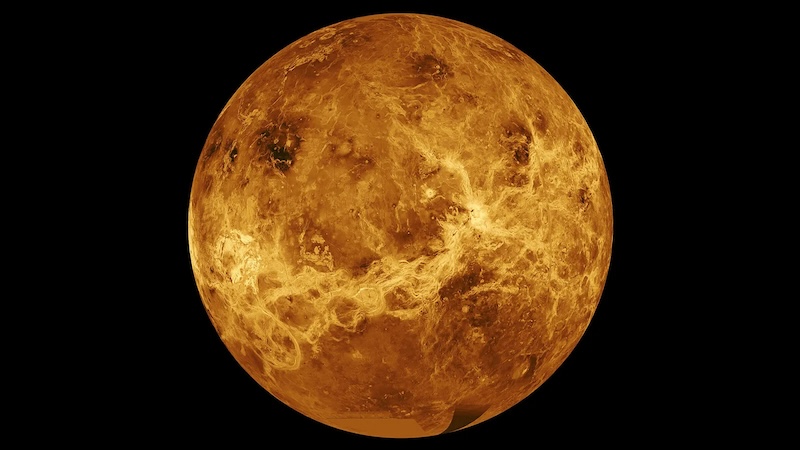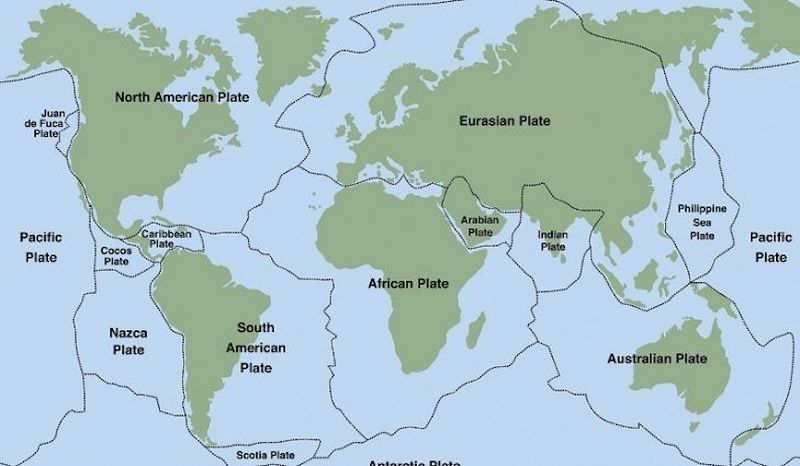
Venus and Earth are similar in size and mass, but took strikingly different evolutionary paths. After all, Earth is – at present – an oasis for life. And Venus, the planet next door, is a boiling hellscape. One reason: Earth has active plate tectonics – rigid land plates moving slowly over an underlying hot, dense mantle – while Venus does not. But maybe Venus had plate tectonics in the past? On October 26, 2023, researchers at Brown University said their new study suggests active plate tectonics for Venus billions of years ago. So … was Venus always a hellscape? Maybe not.
The clues come from the abundance of nitrogen (N2) and carbon dioxide (CO2) in Venus’ atmosphere and the pressure of the atmosphere. The findings also increase the possibility that early Venus could have supported life.
The researchers published their intriguing peer-reviewed results in Nature Astronomy on October 26.
An early form of plate tectonics on Venus
Scientists have long thought that Venus never had any kind of plate tectonics. Rather, the planet’s surface is a stagnant lid, a single planet-wide plate instead of multiple plates. But that may not have always been the case. The paper said:
We find that a continuous single-plate stagnant lid regime operating since antiquity (magma ocean solidification) explains neither the present-day observed atmospheric abundances of N2 and CO2, nor the surface pressure. Instead, the Venusian atmosphere requires volcanic outgassing in an early phase of plate-tectonic-like activity.
The 2024 lunar calendars are here! Best Christmas gifts in the universe! Check ’em out here.
The researchers used computer simulations and atmospheric data to show that Venus’ current atmospheric composition and pressure would only have been possible with an early form of plate tectonics. Specifically, plate tectonics would be required to explain the current abundance of nitrogen and carbon dioxide in the atmosphere. They estimate that Venus had plate tectonics between 3.5 and 4.5 billion years ago. The researchers say it would have been similar to early plate tectonics on Earth, which were occurring at the same time.
Plate tectonics on Venus and Earth at the same time?
Matt Weller is the study’s lead author. He completed the study while at Brown University, and is now at the Lunar and Planetary Institute in Houston. He said:
One of the big picture takeaways is that we very likely had two planets at the same time in the same solar system operating in a plate tectonic regime; the same mode of tectonics that allowed for the life that we see on Earth today.
Co-author Alex Evans at Brown University added:
We’ve so far thought about tectonic state in terms of a binary: it’s either true or it’s false, and it’s either true or false for the duration of the planet. This shows that planets may transition in and out of different tectonic states and that this may actually be fairly common. Earth may be the outlier. This also means we might have planets that transition in and out of habitability rather than just being continuously habitable.
Studying exoplanet atmospheres
Interestingly, the study was originally not even about Venus as much as it was about exoplanets. The researchers were investigating how planetary atmospheres can provide clues about the evolutionary histories of the planets. And they used atmospheric data from nearby Venus in the study. They started with the assumption that Venus was only ever a stagnant lid planet. However, during the course of the study, they found something interesting. The researchers’ simulations of Venus’ atmosphere didn’t match the actual known current atmosphere. This included the current atmospheric pressure and abundance of nitrogen and carbon dioxide. How could that be?
So the researchers tried something different. They simulated what processes would have been necessary to create Venus’ current atmosphere. Surprisingly, the simulations suggested that an early form of plate tectonics would have been required. And the numbers matched almost exactly. In other words, Venus did have early plate tectonics, just like Earth, but then somehow the process halted and Venus became a stagnant lid planet. As Daniel Ibarra at Brown University described:
Venus basically ran out of juice to some extent, and that put the brakes on the process.
Evans added:
We’re still in this paradigm where we use the surfaces of planets to understand their history. We really show for the first time that the atmosphere may actually be the best way to understand some of the very ancient history of planets that is often not preserved on the surface.

Was Venus once habitable?
Today, Venus is a scorched world with crushing atmospheric pressure at the surface. But scientists think it wasn’t always that way, and the new study supports that contention. Could Venus have actually once been habitable on the surface? If Venus did have plate tectonics early on, that would increase the chances that the planet could have supported some kind of life. Plate tectonics were essential in helping to make Earth a habitable world.
On Earth, plate tectonics formed continents and mountains. This lead to chemical reactions that stabilized the planet’s surface temperature, thereby creating an environment more conducive to the development of life. If life ever did start on Venus, it is highly unlikely it could have survived the changing surface conditions that occurred later. However, some scientists theorize that it could still persist today as microbes in the mid-upper atmosphere. Perhaps that might even explain the puzzling and still highly debated detection of phosphine in Venus’ atmosphere.
Knowing more about plate tectonics on Venus will also help scientists better assess and understand the long-term fate of Earth. As Weller noted:
That’s going to be the next critical step in understanding Venus, its evolution and ultimately the fate of the Earth. What conditions will force us to move in a Venus-like trajectory, and what conditions could allow the Earth to remain habitable?
Bottom line: Scientists have long thought that Venus never had plate tectonics. But a new study suggests it did early on, which created the atmosphere we see today.
Source: Venus’s atmospheric nitrogen explained by ancient plate tectonics
Read more: Lightning on Venus? It’s rare, if it exists, says a study











